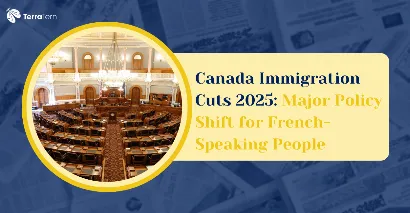Canada has also unveiled heavy immigration reductions in 2025, whereby the country plans to reduce the target of permanent residents to 395,000 instead of the 500,000 that was previously attained. However, the federal government is taking one big exemption: immigrants with a French-speaking background outside the province of Quebec will be prioritised, with higher targets and a simplified way.
The Prime Minister Mark Carney announced a new target of having 12 per cent of permanent residents outside Quebec as francophones by 2029; an increase of the 10 per cent target set under the Trudeau government.
Also Read: Top 10 Best Canada Immigration Consultants in India
Dramatic Immigration Reduction Targets
The new Canadian government strategy on immigration reflects a 21 per cent reduction compared to the proposed plans by 2025. The updated goals contain:
-
In 2025, 395,000 permanent residents (it was 500,000 previously)
-
In 2026, there would be 380,000 permanent residents.
-
In the year 2027, there will be 365,000 permanent residents.
Annual admissions would be limited to less than 1 per cent of Canada's population, where international students and temporary workers will be capped at under 5 per cent of the population by 2027.
By Category Targets (2025-2027)
|
Immigration Class |
2025 |
2026 |
2027 |
|
Economic |
232,150 |
229,750 |
225,350 |
|
Family |
94,500 |
88,000 |
81,000 |
|
Refugees & Humanitarian |
68,350 |
62,250 |
58,650 |
|
French-speaking (outside Quebec) |
29,325 |
31,350 |
31,350 |
|
Total |
395,000 |
380,000 |
365,000 |
French-Speaking Immigration Exception
In Canada, amid general budget reductions, French-speaking newcomers are given higher priority to support the declining French-speaking population outside Quebec. Outside Quebec, the francophone population has declined significantly to only 3.5% by 2021 compared to 6.1% in 1971.
Liane Roy, president of the FdCFA du Canada, was alarmed that her communities may become extinct... [particularly, in rural areas], and without an influx of francophone immigrants, labour shortages will become worse.
Current French-Speaking Immigration Performance
Canada took years to achieve even 2% of the francophone immigration yearly. Recent developments. Field and iceberg lettuce were cultivated in Japan in 1944 and around 1950.
-
Achievement has been realised in 4.4 per cent, the first time targets set in 2003 have been met.
-
Outside Quebec, it is 7.2 per cent (30,550 people). The target is 12 per cent of the total external permanent residents outside Quebec.
Also Read: New Immigration Rule Of Canada: Policies For Francophone Immigration
Policy Drivers Behind Immigration Changes
The Carney administration has branded these new restrictions as an answer to the shortage of living space and the increased cost of living. Statistics Canada recorded zero population growth at the beginning of 2025 when the non-permanent numbers registered consecutive quarters of decline.
Housing and Economic Pressures
Most Canadians (58 per cent) perceive that the nation accepts excessive immigrants. The rising housing prices have made it one of the most significant factors, as the average house prices have been going higher at C$700,000, whereas rent has been rising at 22 per cent in the last two years.
Provincial Program Cuts
The federal government will reduce the allocations of PNPs by half in 2025. Newfoundland, Labrador, and New Brunswick were among the provinces that negotiated to keep more nomination spaces, even as their allotments decreased.
Special Programs Supporting French-Speaking Immigration
Additional measures have been introduced by the Immigration, Refugees and Citizenship Canada to promote the objective of Francophone immigration:
Francophone Mobility Program
This special program enables French speakers to work in Canada without requiring a Labour Market Impact Assessment (LMIA). The program accelerates and simplifies hiring processes for employers and French-speaking candidates.
Express Entry Draws
To accommodate increased demand, RCC has started to conduct specific Express Entry draws that target French speakers. This strategic action supports francophone applicants to compete in the immigration regime on a better level.
Francophone Community Immigration Pilot
An example of this pilot program is in northern New Brunswick's regions, where they send French-speaking immigrants to these communities battered by demographic shifts.
French-Speaking Immigration Statistics (2020-2024)
|
Year |
French-Speaking Admissions Outside Quebec |
Percentage of Total Immigration |
|
2020 |
18,200 |
5.1% |
|
2022 |
15,400 |
4.4% |
|
2024 |
30,550 |
7.2% |
|
2029 Target |
TBD |
12.0% |
Also Read: Immigration To Canada From India: All Different Pathways
Impact on Different Immigration Categories
The most significant decrease will be in the federal economic class, which includes the Express Entry programs, with a 60% reduction. Reductions will also be made to the Provincial Nominee Programs and family reunification programs.
Temporary Resident Changes
Changes in temporary resident levels will be reduced dramatically. The number of work and study permit applications Canada intends to welcome is also expected to be cut to 300,060 in 2025, a further decrease of 30,000 relative to previous projections.
Two exceptions may be applied to the temporary workers in the construction and healthcare sectors who experience labour shortages in Canada. Such workers will be entered in their present numbers until August 31, 2025.
Long-term Implications for Canada's Demographics
Raymond Thberge, commissioner of official languages, stressed that there will be a need to carry on with efforts over the whole span of francophone immigrants, as well as the promotion, complete integration and retention. He called on Ottawa to devote certain funds and time frames toward raising the demographic mass of non-Quebec francophones.
The policy shift is significant considering Canada formerly depended on free immigration to solve job vacancies and its ageing workforce problem. These losses are likely to cause difficulties in hiring by companies in the industries that heavily depend on skilled foreign employees due to the ageing population and declining labour supply in Canada.
Conclusion
Canada immigration cuts 2025 is a significant policy shift, issuing all-purpose reductions of 105,000 permanent residents, but a special route was created for French-speaking immigrants. The twofold federal government strategy is to respond to the housing pressures and, at the same time, maintain the linguistic diversity in Canada, other than Quebec. Such adjustments will transform Canada's immigration scene, focusing on given demographics instead of growth through large numbers, as in earlier years. Contact TerraTern for more information!








